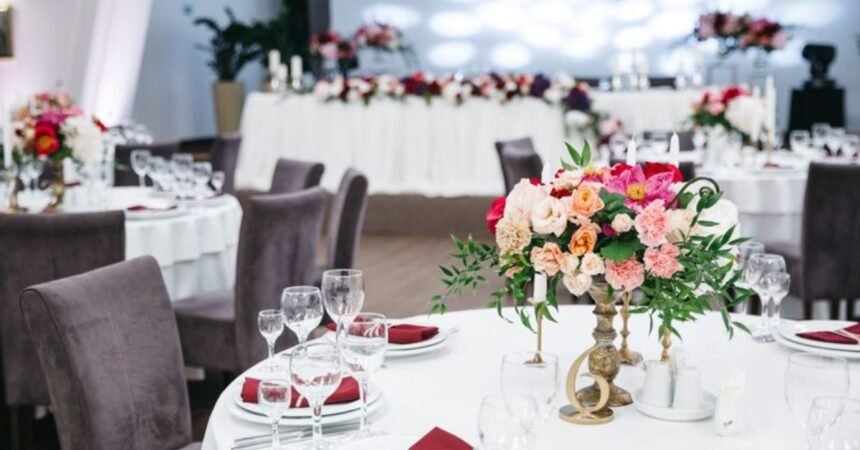Centerpieces are one of the most impactful elements of wedding reception decor. They set the tone, enhance the aesthetic, and serve as conversation starters for guests. According to The New York Times, Centerpieces at Wedding Receptions NYT have become a form of artistic expression, evolving from traditional floral arrangements to a wide range of creative and personalized designs. In this article, we’ll explore everything you need to know about Centerpieces at Wedding Receptions NYT—from their importance to the latest trends, practical applications, and solutions to common challenges. Whether you’re planning an elegant affair or a rustic celebration, choosing the right centerpieces is crucial for creating a memorable event.
What Are Centerpieces at Wedding Receptions NYT?
Definition of Wedding Centerpieces
A wedding centerpiece is a decorative arrangement placed at the center of each reception table. These pieces range from classic floral designs to creative displays that reflect the couple’s personality, wedding theme, or cultural significance. The New York Times highlights that centerpieces are not just about aesthetics; they contribute to the mood, style, and overall flow of the wedding reception. Centerpieces can vary in size, materials, and complexity, making them versatile for any type of celebration, from minimalist weddings to extravagant events.
Key Elements of a Wedding Centerpiece
A wedding centerpiece typically incorporates the following elements:
- Flowers: The most common centerpiece material, available in various styles and sizes.
- Candles: These add warmth and romantic lighting to any table.
- Vases and Containers: These are essential for holding flowers, greenery, or other decorative elements.
- Unique Additions: Items like lanterns, personal artifacts, or edible arrangements are also popular for adding individuality to centerpieces.
Importance and Benefits of Centerpieces at Wedding Receptions NYT
Setting the Tone for the Reception
Centerpieces play a vital role in defining the overall theme and atmosphere of the wedding reception. Whether it’s an intimate garden gathering or a grand ballroom affair, centerpieces are the visual focal point that ties the décor together. For instance, floral centerpieces with soft pastel colors create a romantic ambiance, while vibrant, bold arrangements set a lively, celebratory mood.
The New York Times often emphasizes how centerpieces can transform a basic table into a work of art, capturing the essence of the couple’s style and the wedding’s theme. Simple greenery might evoke a natural, rustic feeling, while glass and metallic elements offer a more contemporary, sleek look.
Encouraging Guest Interaction
Centerpieces aren’t just decorative—they also help encourage conversation. Guests seated around the table may start conversations inspired by the unique arrangement in the center. Whether it’s discussing the flowers used, the cultural significance of certain elements, or the creativity behind non-traditional designs, centerpieces act as a visual icebreaker, helping guests feel more comfortable and engaged.
Personalization and Storytelling
The beauty of wedding centerpieces is that they can tell a story about the couple. A centerpiece can incorporate elements that reflect shared hobbies, travel experiences, or cultural heritage. For example, a couple who enjoys the outdoors may incorporate small terrariums or nature-inspired elements like wood, moss, or feathers. A destination wedding might feature local flora or souvenirs from the location.
Personalization adds a layer of meaning to the wedding reception. It transforms each table into a storytelling medium, allowing the couple to share a part of themselves with their guests in a subtle, artistic way.
Popular Trends in Centerpieces at Wedding Receptions NYT
Minimalist Centerpieces
A growing trend, according to The New York Times, is minimalism. Couples are opting for smaller, more refined designs over large, elaborate floral arrangements. Minimalist centerpieces often feature a few high-quality blooms, combined with sleek, modern vases. Clean lines and neutral color palettes dominate this trend, making the tablescape feel elegant and uncluttered.
Examples include single-stem flowers in glass bottles, low arrangements of succulents, or floating candles in clear vases. These simple designs fit well with modern, urban weddings and give a refined, chic vibe to the reception.
Sustainable and Eco-Friendly Centerpieces
Eco-conscious couples are choosing sustainable options for their wedding centerpieces. This trend involves using locally sourced flowers, potted plants, or reusable materials like recycled glass or wood. The idea is to minimize waste while still creating visually appealing designs. Potted herbs, for example, can serve as centerpieces during the reception and as gifts for guests to take home afterward.
Sustainability extends to the flowers themselves. Many couples are choosing seasonal or dried flowers, which require less water and last longer than fresh blooms. Greenery-heavy centerpieces also align with this eco-friendly trend, using plants like eucalyptus, ferns, and ivy in place of flowers.
Non-Floral Centerpieces
While flowers have traditionally dominated wedding reception tables, many couples now embrace non-floral centerpieces. These creative designs might include candles, lanterns, books, or sculptures. The New York Times highlights how non-floral centerpieces can be both beautiful and functional, offering alternatives that can be customized to the couple’s personality.
For example, books can serve as centerpieces for literary-themed weddings, while small glass terrariums with sand and succulents work well for beach or desert-inspired ceremonies. Other couples choose edible centerpieces like tiered trays of fruit or cheese, which guests can enjoy during the reception.
Interactive Centerpieces
Another trend gaining popularity is interactive centerpieces that guests can engage with. Examples include Polaroid cameras and photo displays where guests can leave messages for the couple. Couples may also include elements like puzzles or mini games that encourage interaction between guests.
Interactive centerpieces add an extra layer of entertainment, especially during periods like cocktail hour or when guests are seated waiting for dinner service. These centerpieces can serve a dual purpose, functioning as both decoration and entertainment, creating a more dynamic atmosphere at the reception.
Bold Colors and Unique Materials
Contrary to the minimalist trend, bold centerpieces featuring bright colors and unique materials are making a comeback. Couples are experimenting with vivid floral arrangements, incorporating colors like deep red, orange, and purple, paired with non-traditional materials such as acrylic, metal, or geometric objects.
These eye-catching centerpieces bring a sense of fun and creativity to the reception, standing out from the more traditional pastel or white themes. This trend works well for couples who want to make a statement with their wedding décor, creating a visually stunning tablescape.
Applications and Use Cases for Wedding Reception Centerpieces
Cultural and Thematic Weddings
For weddings that incorporate cultural traditions, centerpieces often reflect significant symbols or items from the couple’s heritage. In Indian weddings, for example, marigolds are a popular choice due to their significance in celebrations, while red roses or peonies might be used in Chinese weddings to symbolize good fortune and happiness.
Couples hosting themed weddings also use centerpieces to reinforce their chosen theme. A vintage-themed wedding might feature antique candelabras, while a winter wedding could incorporate frosted pinecones and white flowers to evoke a snowy landscape.
Small and Intimate Receptions
In more intimate wedding receptions, where the guest list is smaller, centerpieces take on a greater importance. Because the atmosphere is cozier, the centerpieces help create a warm, inviting ambiance. Smaller, detailed centerpieces—such as intricate floral arrangements, personalized candles, or small figurines—can make a big impact in these settings.
Large and Lavish Weddings
For large wedding receptions, the centerpieces are often grander to match the scale of the event. Towering floral arrangements, cascading greenery, and multiple candles per table help fill the space and create a sense of opulence. Large centerpieces work particularly well in ballrooms or large venues, where the height and volume of the arrangements prevent the décor from feeling too sparse.
Destination Weddings
Destination weddings provide unique opportunities for couples to incorporate the local culture and environment into their centerpieces. A beach wedding, for instance, might use shells, coral, or sand-filled vases, while a Tuscan wedding could feature olive branches, lemons, or wine bottles as part of the table setting.
Challenges and Solutions for Centerpieces at Wedding Receptions NYT
Budget Constraints
One of the biggest challenges when selecting wedding centerpieces is sticking to a budget. Floral arrangements, especially when using exotic or out-of-season flowers, can become expensive quickly. To keep costs down, couples can choose in-season blooms, incorporate more greenery, or opt for smaller arrangements.
Using non-floral materials like candles or potted plants is another way to reduce costs. Renting decorative items, such as vases, candle holders, or lanterns, can also be a cost-effective alternative to buying them outright.
Avoiding Obstructive Designs
While large, dramatic centerpieces are visually stunning, they can sometimes obstruct guests’ views, making it difficult for them to converse across the table. To avoid this issue, couples can choose low-profile centerpieces or opt for tall arrangements with narrow bases that allow guests to see each other clearly.
Matching the Theme Consistently
Another challenge is ensuring that the centerpieces align with the overall wedding theme. If the centerpieces clash with other decorative elements, such as table linens or lighting, the reception might feel visually disjointed. To maintain consistency, couples should work closely with their wedding planner or florist, ensuring that the centerpieces complement the rest of the décor in terms of color, style, and size.
Conclusion
Centerpieces at Wedding Receptions NYT have evolved far beyond traditional floral arrangements. They serve as a focal point, adding personality, style, and storytelling to the event. From bold, colorful arrangements to minimalist, eco-friendly designs, the possibilities for wedding centerpieces are endless. With the right centerpiece, couples can enhance their wedding reception and create a truly memorable experience for their guests.
Whether you’re planning a small intimate gathering or a large, lavish event, centerpieces are an opportunity to showcase creativity and set the tone for your special day. By understanding the latest trends, practical applications, and solutions to common challenges, couples can choose centerpieces that make their wedding day even more unforgettable.
FAQs
1. What are some budget-friendly options for wedding centerpieces?
Using seasonal flowers, incorporating more greenery, and choosing non-floral elements like candles or potted plants can help lower costs.
2. How do I ensure my centerpieces don’t obstruct guest conversations?
Opt for low-profile centerpieces or tall arrangements with slim bases to keep sightlines clear between guests.
3. Can I personalize my centerpieces?
Yes! Incorporating personal items, family heirlooms, or elements from your shared hobbies can make your centerpieces unique and meaningful.
4. What are some eco-friendly centerpiece options?
Consider using potted plants, dried flowers, or locally sourced materials to minimize waste and reduce your environmental impact.
5. What trends are popular for wedding centerpieces in 2024?
Minimalist designs, bold colors, interactive centerpieces, and sustainable options are some of the top trends for wedding centerpieces in 2024.




